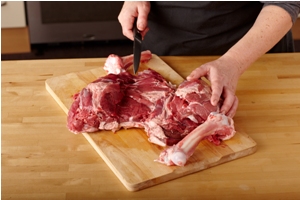Butchers tips

Top tips on choosing, buying, preparing and cooking meat from an award-winning butcher…
Fat
An experienced butcher can often tell the breed, age and sex of an animal just by the colour of its fat. The colour will also depend on what the animal ate during its life. For example, the fat in grass-fed beef may look more yellow than the fat in barley-fed beef, which is usually white. But this doesn’t affect the eating quality – what is important is that the fat is firm and dry.
Meat colour
It’s a common misconception that the redder the meat, the better it is. All a bright red colour really indicates is that the meat has been recently cut. About 20 minutes after cutting the red pigment in meat gradually turns brown. So meat displayed in butchers shops and supermarkets can vary from bright red to reddish-brown, but this won’t affect the eating quality.
Meat that has been matured for longer tends to be darker. The variations in the colour of delicious Welsh Lamb and Welsh Beef disappear once you start cooking it.
How to Butterfly a Leg of Welsh Lamb
Everyone loves trying something new on their barbeque to impress friends and family and upstage the neighbours. And what better way to go gourmet than to serve up some delicious Welsh Lamb? Our step by step guide on how to butterfly a leg of Welsh Lamb will help give you the perfect cut that cooks easily and quickly on the coals, while giving you a tender and tasty meat.
Step 1: Trim outer skin / fat
Using a sharp knife with a fairly long blade carefully remove most of the outer skin, and if there is a fair bit of fat – remove some of the fat. This stage, though not essential, will allow the marinade to penetrate the flesh more resulting in even greater flavour!
Step 2: Cutting out the bone
Turn the leg of lamb over with flat side on the board. Run the knife around the curved bone that protrudes from the wider end of the leg. Slit into the leg as close to the bone as you can. Try not to hack the meat!
Step 3: Remove the bone
Cut around the bone carefully until the bone is exposed and you can cut under it to remove it. You will need to twist and pull it a bit to get the bone out.
Step 4: Remove the knuckle bone
You’ll also find another bone – Knuckle bone, on the narrow end (shank end) of the leg. Run the knife around the bone to loosen it, twist and pull out the bone.
Step 5: Finish
Open/ spread out the boned leg of lamb, and remove any excessive pieces of fat if there are any. Carefully make a horizontal slice into thick part of the flesh, but making sure not to go all the way through. Do this on both sides.
Open out the leg and flatten to resemble a butterfly shape. This should result in a fairly uniform piece of meat.
Final cooking instructions
You are now ready to place the meat into your marinade – leave for a few hours or preferably overnight to ensure it absorbs the flavours of the marinade.





